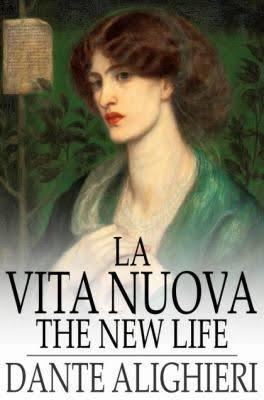6.8 /10 1 Votes
Originally published 1295 | 3.4/5 Poem Hunter | |||||||||||||||||||||||||||||||||
 | ||||||||||||||||||||||||||||||||||
Similar Works by Dante Alighieri, Classical Studies books | ||||||||||||||||||||||||||||||||||
La Vita Nuova ([la ˈviːta ˈnwɔːva]; Italian for "The New Life") or Vita Nova (Latin title) is a text by Dante Alighieri published in 1295. It is an expression of the medieval genre of courtly love in a prosimetrum style, a combination of both prose and verse. Besides its content, it is notable for being written in Italian, rather than Latin; with Dante's other works, it helped to establish the Tuscan dialect as the standard for the Italian language.
Contents
The prose creates the illusion of narrative continuity between the poems; it is Dante's way of reconstructing himself and his art in terms of his evolving sense of the limitations of courtly love (the system of ritualized love and art that Dante and his poet-friends inherited from the Provençal poets, the Sicilian poets of the court of Frederick II, and the Tuscan poets before them). Sometime in his twenties, Dante decided to try to write love poetry that was less centered on the self and more aimed at love as such: he intended to elevate courtly love poetry, many of its tropes and its language, into sacred love poetry. Beatrice for Dante was the embodiment of this kind of love—transparent to the Absolute, inspiring the integration of desire aroused by beauty with the longing of the soul for divine splendor.
la vita nuova dante alighieri
History and context
Referred to by Dante as his libello, or "little book", The New Life is the first of two collections of verse written by Dante in his life. La Vita Nuova is a prosimetrum, a piece which is made up of both verse and prose, in the vein of Boethius' Consolation of Philosophy.
Dante used each prosimetrum as a means for combining poems written over periods of roughly ten years - La Vita Nuova contains his works from before 1283 to roughly 1293.
The first full translation into English was by Joseph Garrow and it was published in 1846.
Structure
La Vita Nuova contains 42 brief chapters (31 for Guglielmo Gorni) with commentaries on 25 sonnets, one ballata, and four canzoni; one canzone is left unfinished, interrupted by the death of Beatrice Portinari, Dante's lifelong love.
Dante's two-part commentaries explain each poem, placing them within the context of his life. The chapters containing poems consist of three parts: the semi-autobiographical narrative, the lyric that resulted from those circumstances, and brief structural outline of the lyric. The poems present a frame story, recounting Dante's love of Beatrice from his first sight of her (when he was nine and she eight) all the way to his mourning after her death, and his determination to write of her "that which has never been written of any woman."
Each separate section of commentary further refines Dante's concept of romantic love as the initial step in a spiritual development that results in the capacity for divine love (see courtly love). Dante's unusual approach to his piece — drawing upon personal events and experience, addressing the readers, and writing in Italian rather than Latin — marked a turning point in European poetry, when many writers abandoned highly stylized forms of writing for a simpler style.
Personality
Dante wanted to collect and publish the lyrics dealing with his love for Beatrice, explaining the autobiographical context of its composition and pointing out the expository structure of each lyric as an aid to careful reading. Though the result is a landmark in the development of emotional autobiography (the most important advance since Saint Augustine's Confessions in the 5th century), like all medieval literature it is far removed from the modern autobiographical impulse. However, Dante and his audience were interested in the emotions of courtly love and how they develop, how they are expressed in verse, how they reveal the permanent intellectual truths of the divinely created world and how love can confer blessing on the soul and bring it closer to God.
The names of the people in the poem, including Beatrice herself, are employed without use of surnames or any details that would assist readers to identify them among the many people of Florence. Only the name "Beatrice" is used, because that was both her actual name and her symbolic name as the conferrer of blessing. Ultimately the names and people work as metaphors.
In chapter XXIV, "I Felt My Heart Awaken" ("Io mi senti' svegliar dentro a lo core", also translated as "I Felt a Loving Spirit Suddenly"), Dante accounts a meeting with Love, who asks the poet to do his best to honour her.
Dante does not name himself in La Vita Nuova. He refers to Guido Cavalcanti as "the first of my friends", to his own sister as "a young and noble lady... who was related to me by the closest consanguinity", to Beatrice's brother similarly as one who "was so linked in consanguinity to the glorious lady that no-one was closer to her". The reader is invited into the very emotional turmoil and lyrical struggle of the unnamed author's own mind and all the surrounding people in his story are seen in their relations to that mind's quest of encountering Love.
La Vita Nuova is essential for understanding the context of his other works — principally La Commedia.
Critical Reception
American poet Wallace Stevens called the text "one of the great documents of Christianity," and noting that the text displays the influence of Christianity in promulgating "the distinctly feminine virtues in place of the sterner ideals of antiquity."
